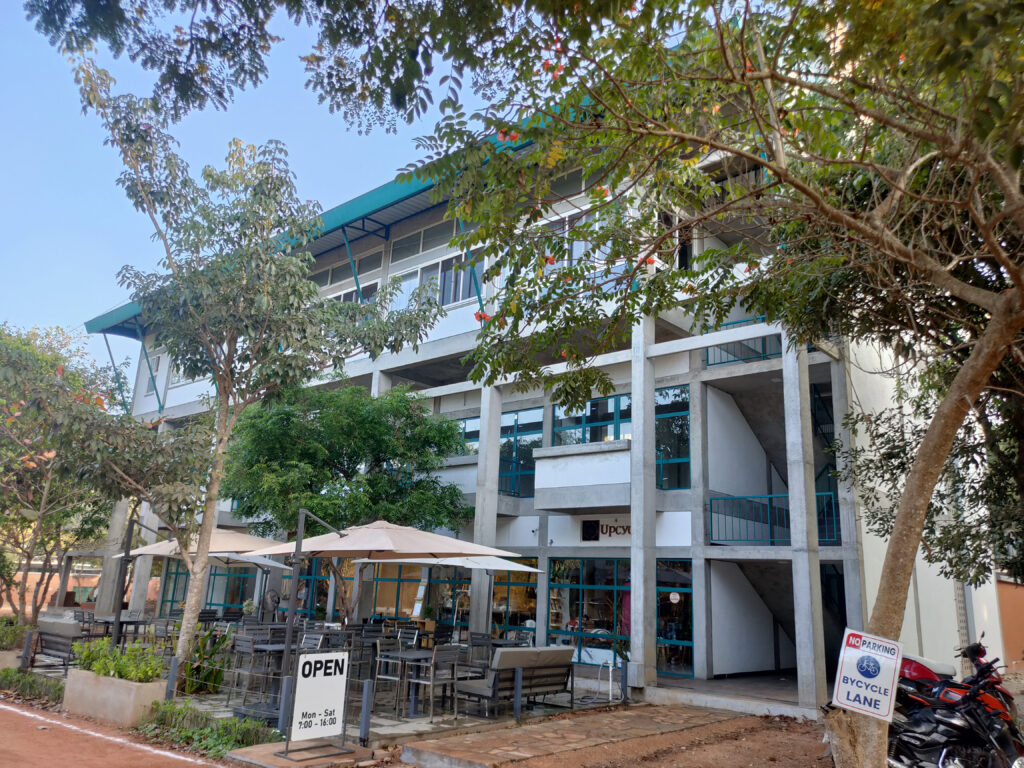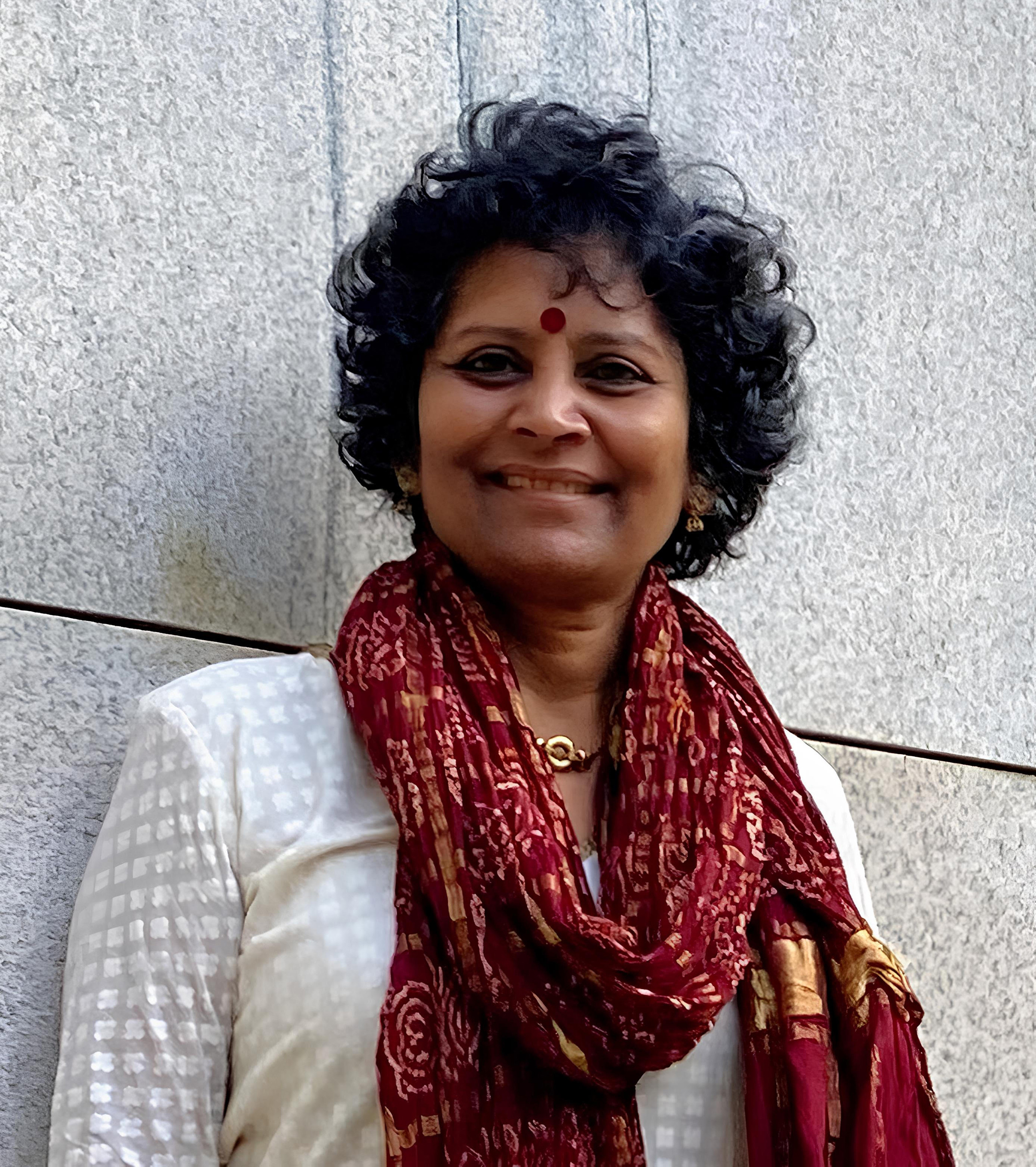UTSAV, a mixed use experimental building complex
Auroville Today Headline Article, April 2024 Issue
AVI USA is collaborating with Auroville Today to bring you the latest Auroville news for the next few months. AVI USA readers will have first access to the unlocked Auroville Today headline articles through the summer through our collaboration with Auroville’s premiere news outlet! You will find the articles in monthly entries on our AVI USA Blog. Please consider supporting and subscribing to Auroville Today!

In November 2019, Auroville Today introduced UTSAV (meaning ‘Celebration’), a combined commercial and residential project which aimed to bring new energy on a major Radial of the Industrial Zone. Now that phase 1A has been completed, Auroville Today talked to Mona, the architect who initiated and supervised the project. What have been the challenges? How successfully have the original objectives been fulfilled, and if there have been changes, what are they and why were they made? And what has she learned from the process?

Auroville Today:
In our 2019 interview you listed some of the initial challenges you faced. As an architect you had chosen to initiate the project, which is not what normally happens, and then you had to get building permission, go for a lengthy tender process, raise the finance, find a project holder and register UTSAV under an Auroville Trust which would take responsibility for the project. And all this before you had even started construction.
Mona: Yes. But we did get building permission, Auromics Trust agreed to be our umbrella organisation, Bobby agreed to be the Project Holder and we had two or three bookings and big hopes! But before we could finally start construction, Covid struck, and this slowed everything down. Finally, we could start only in September 2020. We had many challenges to finish the project, including those who booked not paying up in time, not enough bookings to keep the project running and the Ukraine War with prices rising. Then there was the ruling of the National Green Tribunal which stopped all city construction, and other additional blockages from the Town Development Council. But every time I would appeal to The Mother and she would give me just a little bit of hope, a little more money from somewhere, and with a lot of goodwill from the contractor, Nalla Builders (Baskar) and support from the Project Holder (Bobby), we managed to keep afloat. All this explains why it took us about 3 years to complete the first phase. Finally in November 2023 the first units were ready. So a project initiated in 2017 got completed in 2023!
The original idea was to have commercial units on the ground and first floor with accommodation for volunteers in the apartments above, and one of your hopes was that the units would attract Auroville startups / young entrepreneurs. How did that work out?
Mona: My original idea was to have young people’s commercial start-ups, which is why I designed small spaces, but I realised it’s impossible for young people to afford these places. Even if they could manage to get a 10.5 lakh loan for our cheapest unit, the interest payment would be just too much for them. So we have only managed to accommodate one start-up, and he is still having difficulty in making the final payment.
The volunteers’ accommodation idea also changed. I approached Savi, which looks after volunteers, to finance some units on the second floor, but that didn’t work out, then I hoped that YouthLink would be interested but that didn’t materialise either. Originally, I designed very simple accommodation with shared bathrooms, but people told me that nobody wants to share bathrooms these days. So in the end I decided to make apartments because I thought these are always needed. But these were not taken immediately either, as nobody could afford the cost, 35 or 40 lakhs, of a two bedroom apartment. Many wanted ground floor apartments with small gardens! In November 2022 the situation became very difficult because many of the units had not been taken and we didn’t have the money to finish the construction.
Was there a tipping point when you found enough people to finance the project?
Mona: It was difficult until January 2023 when Akash and Monica came in with Cynergy and The Sprout café (they had been looking for the “right” place for 6 years). They took five units, and soon after Aurelio took the entire top floor for Svaram Atelier research and therapy section. On the ground floor now there will be two cafés (a Naturellement outlet will open soon), and two garment outlets: Colours of Nature and Lively Boutique. On the first floor there is Kalya (Progress landscapes), Cynergy and Sarvam Computers (Bala), and Svaram Atelier is above.
The ‘L’ part of the building, at the rear of the building, has residences on all three floors.
Is it challenging to have a mix of accommodation and commercial units in one building?
Very! It’s complicated because people who are living there want some privacy and don’t want noise at night, but the people who are making money either want as many people as possible to come, and/or to stay open long hours. So we have an agreement that the cafés and offices should not be open after nine in the evening. At one point, one of the cafés wanted to put their tables in a corridor, but I had to say no as that area is for circulation and is paid for by everybody. Also the inner courtyard has been kept open for collective activities / events like food pop ups, open exhibitions, film screenings or music concerts.
There were also complications with accounting because Auroville does not have a structure for a mixed usage project like this. So, everybody’s commercial project payments had to go through their unit, while for accommodation the money went through Housing.
What were your most important learnings?
One is that Auroville needs to create a framework that allows mixed-use buildings to come up. We don’t have such a framework yet, which is why we got sandwiched between Housing and FAMC.
Then, at one point I realised I was no longer just an architect who was also doing project management. I had additionally become a de facto developer who had to ‘sell’ the project to potential buyers. It cost me much time, headaches and here I made all sorts of mistakes. I learned that developers normally have a large share of the money upfront before they attempt to start construction. If you don’t have that and you’re relying upon selling units to be able to start and continue constructing, it is an extremely difficult situation. Also I wanted to be very open with everybody about the costs and how I had arrived at a certain price: I kept perfect accounts of everything. But a developer from Ahmedabad told me that developers never do this: they never show their costings to any of their clients. In fact, normally neighbours will never know who paid what because each case is individually negotiated!
In the beginning it didn’t matter, but when costs escalated towards the end by approximately 12%, people wanted to know how I had calculated certain things. Luckily I had kept clear accounts. I told them that the original agreement I had made with them was that this was a ‘no profit, no loss’ project and, over the time it took to complete it, of course there were cost overruns in materials and labour, so these had to be shared. In fact, materials were bought under the UTSAV GST number and labour was sourced by Nalla Builders, so that helped to keep the costs down, but it meant a lot more work for my Studio.
In the end, UTSAV phase 1A cost 3.6 crores, which is about Rs 3,500 / square foot. It is not the cheapest, but it includes everything – the common areas, overhead and underground tanks, the biological wastewater treatment, covered garage, a generous entrance foyer, payments made to L’Avenir (without which we would not have got permission to start), water connection, a huge open parking area with some landscaping and quality construction, etc. – so I think it is still reasonable.
Then again, we gave everybody the possibility for air-conditioning. I learned this from other communities where AC was not designed for, because I feel that you cannot impose mental concepts, however well-intentioned, on people because life is not like that: we all change.
Another thing I learned was the need for extreme flexibility – not only in the design but also in my mind! So many things happen that are not planned and you have to be ready to adjust. It was good that I did a frame and modular construction for the building because when my original idea for small units or volunteer rooms didn’t work out, I could easily modify internal spaces according to demand, while retaining the external façade.
At the same time, you can’t be too flexible; sometimes you have to hold the line. For example, one of the unit managers wanted to put steel rolling shutters on the ground floor instead of the grills I had planned for security, but I told him that is not possible as I didn’t want UTSAV to look like a dead city complex at night. Everyone made efforts and we found some harmonious solutions to individual problems. It is not as perfect as I would like it to be, but one can learn to live with that!
Overall, I think we managed quite well to do what we intended to do. My initial reference images in the project brochure show Connaught Place in New Delhi and European roadside cafés as inspirations to bring some “urban” character to the Radial. With the double height covered passage and the outdoor café sit-outs of The Sprout and the soon to open Bella Vita (Naturellement outlet), UTSAV will get a character that is urban and welcoming.
Will there be another phase?
Phase 1B will come, and this will be taken up by Miniature, the Italian designer clothing unit. But this time it should be much easier for me as I will only be dealing with one client.
Would you do a project like this again?
No, because I’ve made my learnings, which I am happy to share with others willing to try something like this out, although it will never be the same. I felt inspired to do this, and if things come to me, I think they are meant for my inner and outer growth.
From a conversation with Alan
